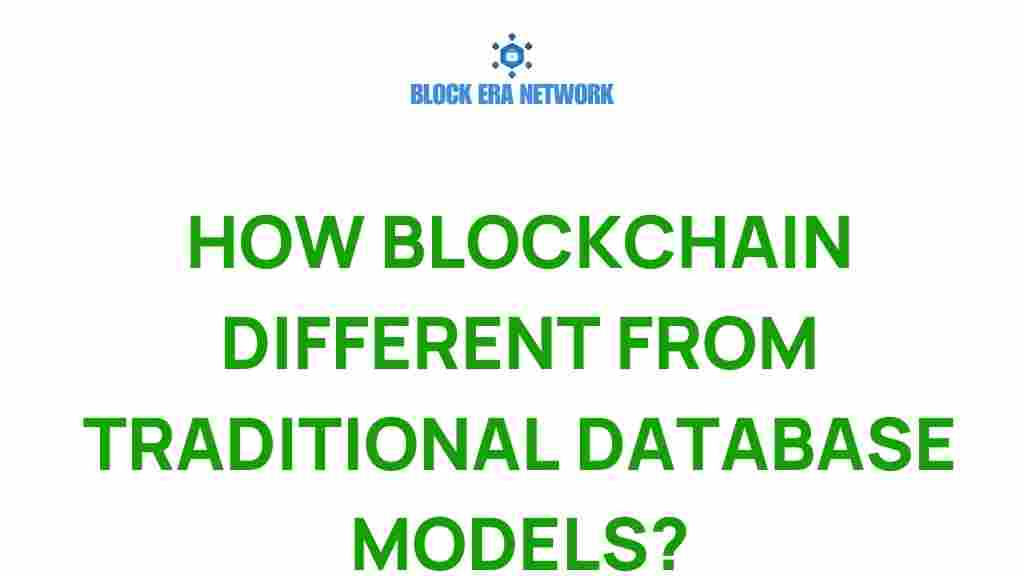Unveiling the Differences: How Blockchain Transforms Traditional Databases
In today’s rapidly evolving technological landscape, the emergence of blockchain technology has sparked significant interest and discussion, particularly in how it contrasts with traditional databases. As organizations seek enhanced data security, improved data integrity, and greater transparency, understanding these differences is crucial. This article delves into how blockchain transforms traditional databases, focusing on key aspects such as decentralization, innovation, and the implications for data management.
Understanding Blockchain and Traditional Databases
Before diving into the differences, let’s clarify what blockchain and traditional databases are.
- Blockchain: A decentralized digital ledger that records transactions across many computers so that the recorded transactions cannot be altered retroactively. This technology leverages cryptography and consensus mechanisms for security.
- Traditional Databases: Centralized systems that store data in a structured format, typically managed by database management systems (DBMS). Data is stored in tables and accessed through SQL (Structured Query Language).
The Key Differences Between Blockchain and Traditional Databases
Let’s explore the fundamental differences between blockchain and traditional databases in terms of various characteristics.
1. Decentralization vs. Centralization
One of the most significant differences between blockchain and traditional databases is their structure.
- Blockchain: Operates on a decentralized model where no single entity has control over the entire database. This decentralization enhances data security and reduces the risk of data tampering.
- Traditional Databases: Centralized systems where a single entity or administrator manages the database. This central authority can create vulnerabilities, as a single point of failure can lead to data breaches.
2. Data Integrity and Security
Data integrity and security are crucial for any data management system.
- Blockchain: Ensures high levels of data integrity through consensus mechanisms and immutability. Once committed to the blockchain, data cannot be altered without the consensus of the network, providing a robust security framework.
- Traditional Databases: While they can implement various security measures, they are prone to unauthorized access and data manipulation. Security relies heavily on the robustness of access controls and can be compromised if the central authority is breached.
3. Transparency
Transparency is another area where blockchain significantly outshines traditional databases.
- Blockchain: Provides inherent transparency as all transactions are recorded on a public ledger that anyone can access. This feature fosters trust among users, as they can independently verify the data.
- Traditional Databases: Typically lack transparency. Access to data is limited to authorized users, and there is often no way for outsiders to verify the data without going through the central authority.
4. Innovation and Use Cases
Blockchain is a catalyst for innovation in various sectors.
- Blockchain: Powers new applications such as cryptocurrencies, smart contracts, supply chain tracking, and decentralized finance (DeFi). Its potential for innovation is vast and continues to expand.
- Traditional Databases: While they support a broad range of applications, they are limited to conventional data management tasks and lack the innovative capabilities presented by blockchain technology.
Step-by-Step Process: Implementing Blockchain Solutions
For organizations looking to leverage blockchain technology, here’s a step-by-step process to implement blockchain solutions:
Step 1: Define Objectives
Identify the specific problems you aim to solve using blockchain, such as enhancing data security or improving transparency in transactions.
Step 2: Choose the Right Blockchain Platform
Evaluate various blockchain platforms based on your requirements. Some popular options include:
- Ethereum
- Hyperledger Fabric
- Ripple
Step 3: Design the Blockchain Architecture
Determine whether you need a public, private, or consortium blockchain based on your data integrity and privacy needs.
Step 4: Develop Smart Contracts
Smart contracts automate processes and can enhance efficiency. Develop and test smart contracts that align with your objectives.
Step 5: Integrate with Existing Systems
Ensure that your blockchain solution can integrate with existing systems and workflows. This will require collaboration between IT and business teams.
Step 6: Conduct Testing
Thoroughly test the blockchain system to identify any issues. This includes testing for security vulnerabilities, performance, and user experience.
Step 7: Deployment and Monitoring
Deploy the blockchain solution and continuously monitor its performance. Gather user feedback to make necessary adjustments.
Troubleshooting Tips for Blockchain Implementation
Implementing blockchain can come with challenges. Here are some troubleshooting tips:
- Performance Issues: If your blockchain network is slow, consider optimizing the consensus mechanism or increasing the number of nodes.
- Security Concerns: Regularly audit smart contracts and the network for vulnerabilities. Employ best practices for cryptographic security.
- Integration Problems: Ensure that APIs and middleware are correctly configured to facilitate seamless integration with legacy systems.
Conclusion
In conclusion, the transformation of traditional databases through blockchain technology marks a significant advancement in how we manage and secure data. With its decentralization, enhanced data security, and transparency, blockchain offers a compelling alternative to conventional database systems. As organizations continue to explore the potential of blockchain, understanding these differences will be critical for harnessing its full capabilities.
For more information on blockchain technology and its applications, visit this resource.
To learn more about traditional databases, check out this link.
This article is in the category Blockchain Basics and created by Block Era Network Team

3 thoughts on “Unveiling the Differences: How Blockchain Transforms Traditional Databases”